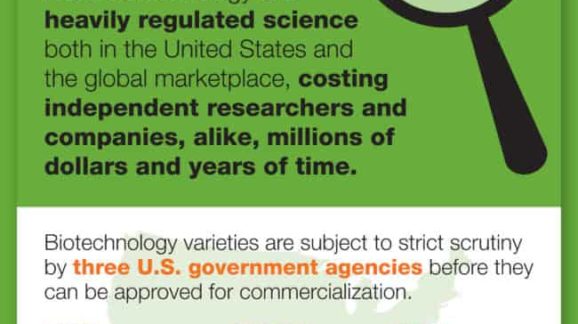INFOGRAPHIC: The Cost of Regulating Biotechnology and Genetically-Engineered Food

This spring, legislators in more than 20 U.S. states will consider proposals to mandate special labeling of genetically-engineered (GE) foods, but there is a deep misunderstanding about what genetic engineering means, and the safety and regulation of genetically-engineered food.
What does “genetically-engineered” mean?
From cornflakes to cupcakes, nearly every food on grocery store shelves has been genetically modified by human hands in ways that help farmers raise crop yields, protect plants from pests or disease, or increase a food’s nutritional value. Genetic engineering is one of the many tools used to do this. But whether we use GE or conventional methods, breeding may mean simply tweaking the genes already inside a plant or introducing entirely new genes. What makes GE unique is the precision it gives us to select individual genes, while conventional methods change thousands of genes at a time. That precision also makes it easier to test the safety of GE foods for consumers and the environment.
How do I know what is in a “genetically-engineered” food?
It is important for consumers to understand genetic engineering is not “in food”; it is just one of the many ways a food’s ingredients can be modified at the genetic level. On the other hand, the U.S. Food and Drug Administration (FDA) already requires labeling to inform consumers when an ingredient is changed in a way that could affect its safety, nutrition, and even taste or smell. These labels provide far better information about what is actually in your food than simply labeling a product as “genetically engineered.”
Is “genetically-engineered” food safe?
GE foods are among the most extensively tested products in history, and in 30 years of commercial use in countries around the globe, they have not caused a single sniffle, sneeze, or bellyache. Seed breeders spend an average of 5 to 10 years developing and testing GE products. Then, government regulators spend two to four more years reviewing the safety of those products before they make it to market.
Check out CEI’s latest infographic on the regulation and safety of biotechnology and genetically-engineered products.
